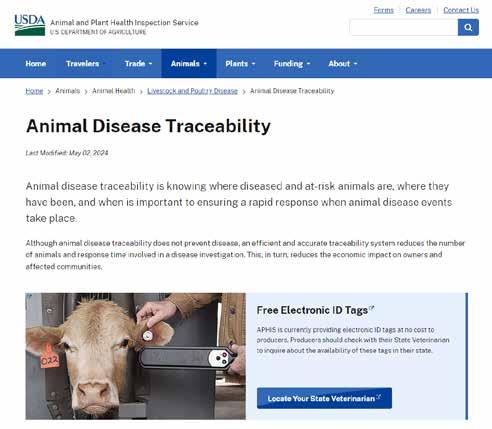
9 minute read
Animal Disease Traceability Rule Infrequently Asked Questions
Michelle Arnold DVM (Ruminant Extension Veterinarian, UKVDL)
In a USDA press release issued on April 26, it was announced that a new rule titled, “Use of Electronic Identification (EID) Eartags as Official Identification in Cattle and Bison,” was finalized. This final rule is an amendment to the animal disease traceability regulations already in place as of January 2013. The new rule requires eartags to be both visually and electronically readable to be recognized as official eartags for interstate travel for cattle and bison covered under the regulations. In addition, the amendment revised the definition of dairy cattle, clarified certain recordkeeping requirements and revised requirements for cattle moving to slaughter. This final rule is specifically focused on improving our ability to trace LIVE animals accurately and rapidly to contain disease outbreaks before they do substantial damage to the cattle industry. The rule will be published in the Federal Register in the coming weeks and will take effect 180 days after its publication. APHIS maintains an Animal Disease Traceability webpage with direct access to the Final Rule, FAQs, how to obtain free electronic ID tags, and other resources at https://www.aphis. usda.gov/livestock-poultry-disease/ traceability. This article will attempt to address some of the less frequently asked questions about important aspects of the new rule.
Has anything changed with this new rule regarding which cattle are required to have “official identification” when moving interstate?
No, the final rule does not change the categories of cattle and bison subject to the official ID requirements for interstate movement. Cattle and bison that move interstate and fall into specific categories need official, individual eartags that now can be read both visually and electronically. The requirement for individual identification does not include feeder cattle, nor any cattle or bison moving directly to slaughter.
Beef cattle (and bison) that currently require official ID:
◊ All sexually intact beef cattle and bison 18 months of age or over;
◊ Cattle and bison of any age used for rodeo or recreational events; and
◊ Cattle and bison of any age used for shows or exhibitions.
Dairy cattle that currently require official ID:
◊ All female dairy cattle of any age and all dairy males born after March 11, 2013; The new rule revised the definition of dairy cattle as follows: “All cattle, regardless of age or sex or current use, that are of a breed(s) or offspring of a breed used to produce milk or other dairy products for human consumption, including, but not limited to, Ayrshire, Brown Swiss, Holstein, Jersey, Guernsey, Milking Shorthorn, and Red and Whites.”
According to the revised definition of “dairy cattle”, the offspring of a dairy animal requires official ID for interstate movement. Does this include Beef on Dairy calves?
Yes! According to the final rule, “APHIS’ operational guidance has consistently held that beef/dairy cross bred cattle fall under the definition of dairy cattle and are therefore already required to have official identification; our change to the dairy cattle definition codifies this longstanding guidance regarding how to interpret the regulations. Beef/ dairy cross breeds should already be officially identified. We have no indication of noncompliance or controversy surrounding this policy. We acknowledge the possibility that there may be cattle producers that did not consider their beef/dairy cross breeds to be dairy cattle and were alerted to our interpretation of the definition of dairy cattle to encompass beef/dairy cross breeds by this rulemaking.” In addition, the revision states that the official ID numbers of all dairy cattle, regardless of whether they are sexually intact, must be recorded on the Interstate Certificate of Veterinary Inspection (ICVI or “Health Certificate”).
Why would Beef on Dairy calves be at higher risk for disease?
“As stated in the proposed rule, dairy farm management practices, such as pooling colostrum from multiple cows for many calves, commingling calves at different locations during their lifetimes, and movement to many destinations, result in a higher risk of disease transmission. Beef/ dairy crosses born on dairy farms are likely to be exposed to these practices, especially in early life; therefore, they are at an increased risk of disease transmission.”
The final rule added several recordkeeping requirements for official identification. Currently anyone (state, tribe, accredited veterinarian or person) who distributes official ID devices must maintain records of recipient names and addresses for five years. How did this change?
The final rule added that the official ID distribution records must be entered by the person distributing the devices into a database designated by APHIS. Any eartags applied by a federally accredited veterinarian must also be recorded in a readily accessible database available to APHIS in the event of a traceback. However, a producer who applies official ID tags to his or her own animals but does not distribute the tags to anyone else does not fall under the recordkeeping reporting requirement.
APHIS did add a new paragraph stating that required records must be maintained by the responsible person or entity and “be of sufficient accuracy, quality and completeness to demonstrate compliance with all conditions and requirements” of the final rule. It further requires that APHIS be allowed access to all records during normal business hours, to include visual inspection and reproduction (e.g., photocopying, digital reproduction), and the responsible person or entity must submit to APHIS all reports and notices containing the information specified within 48 hours of receipt of request for records.
Is a PIN still required to acquire and apply EID tags?
Yes. The PIN (premise ID number) is a nationally unique number assigned to a premise, usually issued through the state animal health official, that is a “geographically distinct location.” The PIN is associated with the location the tag was placed on the animal, not the location of the cattle owner. “All currently approved EID eartags (RFID AIN “840”eartags) are associated with a PIN or a state location identification number (LID), inasmuch as a PIN or a LID is required for” acquisition of the tags. “A PIN is the numerical equivalent of a 911 postal address or a GPS number. A LID is the state-managed equivalent for producers who prefer to have the state store their information, rather than the federal government.”
This final rule does not require producers to purchase and affix EID eartags to their cattle as the only acceptable official identification device or method to meet the official identification requirements for interstate movement; the regulations continue to list eartags as one of several forms of authorized official identification, which also include tattoos and brands when accepted by state officials in the sending and receiving states. (See Frequently Asked Questions at the APHIS website for further information).
Given that a major reason for this new official ID rule is to keep transcription errors to a minimum, why does APHIS still require a visually-readable tag?
The 15-digit identification number currently used for all approved EID eartags begins with the same six digits: 840003. The first 3 digits are the country code, which is 840 for the United States. The following 3 digits, 003, signify a sequential numbering system from a start number of 003,000,000,000. Therefore, an individual visually reading an EID tag would only read 9 unique characters (the characters following 840003). These characters are only numbers, with readability standards including larger font size and color contrast. A transcription error “is not likely to significantly increase from the current state when relying on visual read of the eartag; if anything, several factors should make it easier, not harder, to transcribe the tag number. However, the use of EID tags would allow for an electronic read of the tag if a transcription error were believed to have occurred.” This final rule does not require producers or livestock markets to have electronic reading equipment or additional data management systems, because the official EID tags must be readable visually as well as electronically. RFID tags were previously categorized as either “Low Frequency” (LF) or “UltraHigh Frequency” (UHF). This final rule refers to RFID tags as “HDX” or “FDX”. Are these terms similar?
The RFID tag technology can be categorized by the radio frequency range it uses to communicate, either low (LF) or ultrahigh frequency (UHF)—whichever the state, producer or industry sector prefers. Low frequency tags have a shorter read range, and only one tag can be read at a time. UHF has an extended read range of up to 30 feet, faster data transfer and is better suited to capturing load lots of cattle.
However, RFID can also be categorized by the way information is transferred between the tag and reader, either “Half Duplex (HDX) or “Full Duplex” (FDX). HDX tags are heavier. They transmit information one way at a time and are better able to transmit through interference such as metal objects. They have the strongest read range. FDX eartags are lighter in weight. They transmit information continuously but are more susceptible to interference from metal objects and fluorescent lights. Regardless of type, all RFID tags must be approved by USDA and meet standards for quality and performance, be tamper proof, contain a unique ID, and display the U.S. official eartag shield.
What if the animal already has “official identification” such as the NUES Metal Tag or a visual-only tag? Does it have to be removed or will it be required to apply an additional electronically-readable tag?
No, all visual-only official ID tags applied prior to the date the rule is effective will be considered official identification for the animal’s lifetime including the metal NUES tags (Figure 2), commonly referred to as “silver” or “brite” tags, and the Brucellosis Vaccination metal tag, an orange metal tag that indicates the animal was calfhood vaccinated for Brucellosis (Bangs Disease). However, a visually and electronically readable official eartag may be applied to animals currently identified with non-EID official eartags or Brucellosis vaccination tags, even though this results in more than one official eartag in an individual animal.
What must be on an official ear tag?
USDA Official Eartags (Figure 3) are designed for one-time use (tamper evident) and imprinted with:
◊ A unique animal identification backtag) unless held up for more than three days. This final rule clarifies that animals may only move to another slaughter establishment or approved feedlot, with appropriate documentation



Stoltzfus’ unique dual wheel offers fertilizer precision with the toughness, longevity multi-product application


